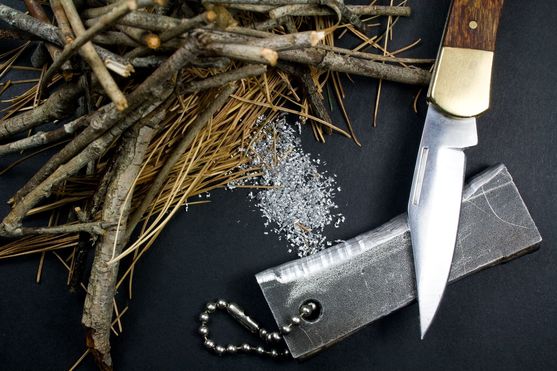Caught in the great outdoors, you might find yourself in need of shelter—fast. Shelter is crucial for survival, guarding against harsh weather and keeping you safe from the elements.
This guide will show you how to use natural materials to build a sturdy temporary refuge with ease. Let’s get started on your lifesaving haven!
Table of Contents
- Selecting the Right Location for a Shelter
- Necessary Tools for Building a Natural Shelter
- Building a Lean-To Shelter with Natural Materials
- Constructing Side Walls for Additional Protection
- Creating a Sleeping Platform for Comfort
- Different Types of Natural Shelters
- Conclusion
- FAQs
- What materials can I use to build a temporary shelter in the wild?
- Is it safe to build a shelter near water sources?
- How long does it take to build a natural material shelter?
- Can I make my temporary shelter warm without modern tools?
- What is the most important factor when choosing a location for my temporary shelter?
Key Takeaways
- Choose a shelter location that offers natural protection against the elements, such as wind and rain, and is safe from potential hazards like water collection or falling branches.
- Essential tools for building a temporary shelter include a fixed – blade knife, folding saw, paracord or twine, lightweight hammer or mallet, sharpening stone for maintaining your knife edge, work gloves to protect hands and ensure better grip on materials.
- A lean-to shelter’s construction involves securing a strong ridge pole between two trees at shoulder height as the framework. Then, layer branches are angled against this pole with leaves or other natural materials layered like shingles for roofing.
- Enhance insulation and comfort by creating sidewalls with vertical supports filled in with smaller materials and constructing a raised sleeping platform lined with soft insulating debris like dried leaves or pine needles.
- Familiarize yourself with different types of natural shelters suitable for various conditions—Round Lodges shield from diverse weather elements; Quinzhees utilize snow’s insulation in cold environments; Snow Caves require strategic digging into packed snow drifts; Wicki-ups involve assembling deadwood frames covered in foliage; Leaf Huts are insulated by layers of leaves over leaned-together branches.
Selecting the Right Location for a Shelter
Choosing the right spot for your survival shelter is a critical first step. Look for a place with natural protection against wind and rain, such as an area near trees that can act as a barrier.
These trees will also provide valuable materials like branches and leaves when constructing your lean-to or A-frame shelter. Your chosen location should have good insulation from the cold ground, which could be dry leaves or grass.
Make sure to stay clear of valley floors and depressions where water can collect and avoid setting up on bare mountain tops where you’re exposed to harsh elements. Instead, seek out level ground that’s elevated just enough for water runoff without being too steep.
This will help ensure you stay dry and reduce exposure to severe weather conditions while maximizing comfort in your outdoor survival situation. Always prioritize safety by considering potential hazards like falling tree branches—your ridge pole won’t mean much if it’s not securely placed in a safe environment!
Necessary Tools for Building a Natural Shelter
Building a natural shelter requires specific tools that are essential for the construction process. These tools not only make the job easier but also ensure your shelter is stable and durable.
- A fixed-blade camping knife: This is a versatile tool crucial for cutting cordage, carving wood, and shaping various materials needed to build your shelter.
- Folding saw: When you need to cut through thicker branches or logs, a folding saw can do the job efficiently without taking up much space in your backpack.
- Paracord or sturdy garden twine: Strong and reliable, paracord is perfect for lashing together poles and securing different parts of your structure. It’s lightweight and exceedingly tough.
- Cordage: Aside from paracord, having additional rope or twine can be crucial for tying knots, creating lashings like the square lashing, and reinforcing your shelter against wind or snowfall.
- Lightweight hammer or mallet: This will come in handy when you need to drive stakes into the ground to secure your shelter’s foundation or framework.
- Sharpening stone: Keeping your knife blade sharp is vital when outdoors; a dull knife can make constructing a shelter more difficult than it needs to be.
- Work gloves: Protecting your hands from blisters and cuts is important. Gloves also provide a better grip when handling rough materials.
- Measuring tool: Having a ruler or tape measure ensures that you cut branches to the right size, creating a uniform and structurally sound shelter.
Building a Lean-To Shelter with Natural Materials
Discover the art of constructing a sturdy lean-to shelter using only the bounty of nature, an essential skill for any outdoorsman that not only offers immediate protection from the elements but also imbues a sense of achievement — keep reading to see how you can master this invaluable outdoor technique.
Fixing a Ridge Pole
Begin by choosing a ridge pole that meets the necessary strength requirements for your lean-to shelter. This vital component should be robust, with at least three inches in diameter to support the weight of your structure securely.
Carefully place it between two sturdy trees or upright supports at a height suitable for your shelter’s design. Ensure it’s positioned horizontally and evenly to provide a stable framework for the materials you’ll layer on top.
Secure the ridge pole firmly using cordage or vines, tying tight knots that won’t slip under pressure. The knot you choose can make all the difference in lasting stability – opt for hitches or lashing techniques that lock into place as tension is applied.
Check each connection point along the length of the ridge pole to confirm there’s no movement, giving you peace of mind that your emergency preparedness skills are building a durable refuge against nature’s elements.
Creating a Lean-To
To create a lean-to, start by finding two sturdy trees about 7 to 10 feet apart. Secure a strong horizontal ridge pole at shoulder height between them. This is the backbone of your lean-to and must be solid enough to hold the weight of other materials.
Look for fallen branches or cut saplings that can endure the elements; they will act as support for your shelter’s framework.
Next, gather long branches and position them at an angle against the ridge pole, creating a sloped wall on one side. Make sure these are spaced closely enough so that leaves, pine needles, or other natural roofing materials can rest securely on top without falling through gaps.
Using flexible branches will help weave them together tightly, granting extra durability to this woodland abode designed for Everest-level survival in nature’s untamed environments favored by backpacking adventurers and ramblers alike.
Lashing Horizontal Spars
With the lean-to framework taking shape, it’s time to secure horizontal spars for added stability. Carefully position your spars so they weave alternately over and under each vertical stave, ensuring they are evenly spaced along the ridge pole.
This creates a robust structure that can withstand the elements. Lashing these horizontal members is crucial; use square or Japanese lashing techniques to tightly bind them at points where they cross the staves.
This firm connection prevents any unwanted movement and solidifies your shelter’s overall integrity.
Crafting a sturdy frame is one thing, but making sure each element holds together under stress takes precision and patience. Opt for strong, reliable knots that will hold fast even in windy conditions—Japanese lashing works well here because of its interlocking design, which grips tightly as tension increases.
Remember to lash both ends of each spar securely to prevent sagging or shifting over time. Your lean-to should now have a reinforced structure capable of supporting whatever natural roofing materials you choose next in building your temporary outdoor haven.
Completing the Lean-To Frame
Once your horizontal spars are securely lashed to the ridge pole using Japanese lashing, it’s time to focus on the lean-to frame’s completion. Gather thin branches and weave them between the spars to fill any gaps.
This adds a layer of density and stability that will support additional roofing materials.
Ensure you lock off the ridge pole by wedging a secondary branch at an angle against this main support. This critical step prevents movement or collapse caused by strong winds, securing your shelter firmly in place.
Remember, careful attention to these details transforms your lean-to from a mere structure into a sturdy refuge against nature’s elements.
Locking off the Ridge Pole
After securely positioning the lean-to frame, the focus shifts to the ridge pole—a crucial component of your shelter. It must be solid enough to withstand the forces of nature and bear the entire weight.
To ensure this, select a sturdy branch around three inches in diameter for optimal support.
Next, firmly lock off the ridge pole using a secondary branch as reinforcement against twisting or collapsing under strong winds. This step is vital; it stabilizes the structure by preventing any movement that could compromise its integrity.
Secure this backup limb with tight lashings at strategic points where stress is greatest, safeguarding your efforts and ensuring lasting stability for your natural shelter.
Roofing Your Shelter
Putting a solid roof on your lean-to shelter is crucial for staying dry and protected from the elements. You’ll need branches, leaves, or even a tarp to create a barrier against the weather.
- Gather ample roofing materials like large leafy branches, pine boughs, or ferns, which can be found near your selected site.
- Begin at the bottom of your shelter’s frame and layer the natural materials so they overlap like shingles on a roof; this ensures water runs off without leaking into your shelter.
- Secure each layer tightly to the frame to minimize gaps where wind or rain could penetrate; for this, use additional smaller branches or vines as ties if available.
- Add several layers until you have achieved the desired thickness; more layers will provide better insulation and increased protection from rain and wind.
- If using a tarp, stretch it over the ridge pole first before piling on natural materials for added waterproofing.
- Anchor down the edges of your tarp with heavy rocks or tie them off to nearby trees to prevent it from flapping in windy conditions.
- Inspect your work carefully, filling in any holes where daylight peeks through with extra leaves or moss to fortify against potential leaks.
- Double-check that everything is secure by gently tugging at various points; loose parts may need more reinforcement.
Constructing Side Walls for Additional Protection
Constructing side walls for your lean-to shelter is crucial for blocking wind and retaining warmth. Properly built walls provide not just comfort but also essential protection from the elements.
- Start by gathering sturdy branches, ideally collecting fallen wood instead of cutting fresh branches to minimize damage to living trees. Look for pieces similar in length that can serve as vertical supports.
- Place these vertical support staves firmly into the ground along both sides of your lean-to structure, spacing them about a foot apart to create a strong framework.
- Next, find thinner branches or spars to weave horizontally through your vertical supports. Intertwine them tightly; this latticework adds stability and forms the base of your sidewalls.
- Ensure that each spar is securely lashed at the intersections with cordage or vines, if available, reinforcing the structure against wind pressure.
- Fill in the gaps between the weaved spars with leaves, moss, or smaller twigs. These materials will act as insulation and help prevent cold drafts from entering the shelter.
- Finally, pack additional earth or snow around the base of your walls to seal any remaining gaps further. This step enhances thermal retention and bolsters wall strength.
Creating a Sleeping Platform for Comfort
A proper sleeping platform raises you off the ground, providing comfort and warmth. You’ll sleep better and stay dryer with the right setup built from materials found in nature.
- Choose a flat area inside your shelter for the sleeping platform, away from any walls or openings that might let in rain or wind.
- Gather large, sturdy branches to create a stable framework. Make sure they’re strong enough to hold your weight without bending.
- Lay the branches side by side on the ground, forming the base of your platform. They should be close together to provide even support.
- Find smaller twigs and leaves to use as filler material. Weave these between the larger branches to fill in gaps and create a smoother surface.
- Pile on a thick layer of soft debris like dried leaves, pine needles, or grasses for insulation from the cold ground. The more you add, the warmer you’ll be.
- Finally, lay out any additional coverings you have—a tarp or emergency blanket can help reflect heat back toward you and provide an extra barrier against moisture.
Different Types of Natural Shelters
Exploring the diversity of natural shelters, from the insulated quinzhee to the sturdy wicki-up, reveals a myriad of ways to harness the environment for protection – delve into their unique characteristics and uses in our comprehensive guide.
Round Lodge
A Round Lodge combines the expertise of many cultures to create a sturdy and versatile shelter. Its unique design effortlessly blocks wind, rain, cold, and sun, making it an ideal refuge in varied environments.
Campers gather materials like tarps, mats, brush or even snow to start construction. They begin by strategically piling snow for insulation or tying down tarps for immediate coverage.
Builders employ techniques such as suspending cordage from a central pole or using multiple poles arranged in a circle for support. These structural elements are critical as they uphold the lodge’s integrity against harsh weather conditions.
The carefully assembled Round Lodge invites campers into an elemental experience closely connected with nature while providing essential protection from the elements.
Quinzhee
Moving from the traditional structure of a round lodge, let’s delve into constructing a Quinzhee—a shelter particularly suited for snowy landscapes. Unlike the typical wooden support of lodges or tipis, this igloo-like sanctuary harnesses the insulating properties of snow to provide warmth and protection during biting cold weather.
To build one, campers shape large mounds of snow that are then meticulously packed and sculpted until they can be hollowed out to create an enclosed space.
The process may sound simple, but it requires attention to detail and patience; after piling up the snow, it must sinter or partially melt and refreeze to strengthen its form before excavation begins.
Once inside, you’ll find the interior quite cozy despite frigid temperatures outside—the walls act as barriers against wind chill while trapping body heat within. Survivalists often opt for a Quinzhee when other materials are scarce, relying on its natural efficiency to brave harsh winter conditions.
Snow Cave
Building a snow cave requires careful consideration of the surrounding environment. It’s essential to choose an area with sufficient snow depth and stability for construction. Start by digging into the side of a drift or hill where the snow is packed and less prone to collapse.
As you hollow out the cave, make sure to create a dome-like shape for strength and durability. The walls should be smooth to prevent dripping and slightly sloped so that cold air stays low, away from your sleeping platform.
Proper ventilation in a snow cave is critical to reduce the risk of suffocation. Poke a small hole near the top of your dome as an airway – this allows fresh oxygen to flow in while letting out any carbon dioxide build-up.
A well-constructed entrance tunnel that dips below living space level works effectively as both access point and cold trap, keeping warmer air inside from escaping through convection.
Using natural materials like grasses or branches can add insulation while ensuring good airflow throughout your temporary snowy home. Remember, safety comes first; double-check structural integrity periodically during your stay.
Wicki-Up
For a durable and natural wicki-up shelter, finding robust deadwood is key. Opt for recently fallen branches that can support weight without harming the living forest. Start by securing a sturdy ridge pole around three inches in diameter as the backbone of your structure.
Then, gather staves, horizontal spars, and flexible branches to create the framework.
Crafting your wicki-up involves weaving natural materials like grasses or inner tree bark throughout the frame for added stability. Use withies or twine from nettles to bind everything tightly.
Your choice of materials not only ensures strength but also blends seamlessly with nature’s design, making your temporary home both practical and environmentally conscious.
Leaf Hut
Crafting a leaf hut stands as a vital survival skill, one that could very well save your life in an emergency. To build this natural haven, start by finding suitable materials like twine and the flexible inner bark of trees.
A sturdy frame comes next—using staves to form the structure’s backbone. Weave in thinner branches between these staves to reinforce what will be your leaf hut’s supporting roof.
Cover your lean-to frame thoroughly with leaves and grasses, making sure that every inch provides ample insulation against wind and rain. A thick layer is key for trapping air and maintaining warmth throughout chilly nights.
Positioning your leaf hut near a campfire can amplify the shelter’s protective qualities, ensuring that you stay dry and secure from the harsh elements outdoors.
Conclusion
As we’ve explored, harnessing the wilderness to create a temporary shelter is both an art and a crucial survival skill. With the right tools and knowledge of natural materials, anyone can construct a sturdy refuge in the wild.
Remember to choose your location wisely and respect nature by using materials like fallen deadwood. Your new skills will empower you to stay safe and dry whatever adventures come your way.
Get out there, use these tips, build with confidence, and take on the great outdoors!
FAQs
What materials can I use to build a temporary shelter in the wild?
You can use branches, leaves, moss, and mud to construct a sturdy temporary shelter in nature.
Is it safe to build a shelter near water sources?
Choosing higher ground away from immediate water sources reduces the risk of flooding and unwanted wildlife encounters.
How long does it take to build a natural material shelter?
With some practice and depending on local resources, you could build a basic natural material shelter in just a few hours.
Can I make my temporary shelter warm without modern tools?
Insulating your shelter with leaves, grasses or snow can help retain heat and keep the interior warm.
What is the most important factor when choosing a location for my temporary shelter?
The safety of your chosen spot—away from hazards like falling branches or rock slides—is crucial for building your temporary shelter.







Leave a Reply